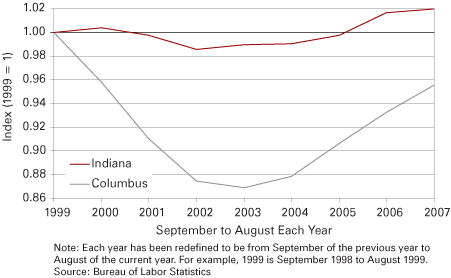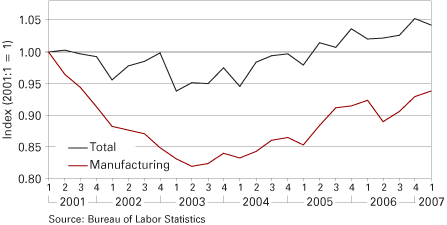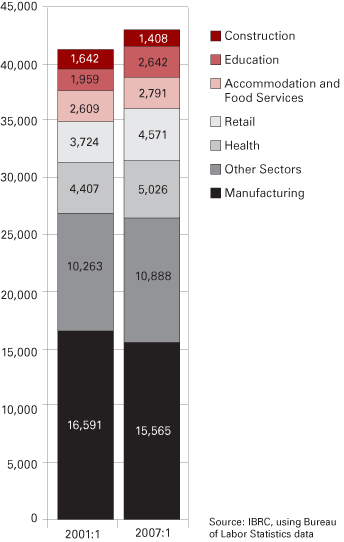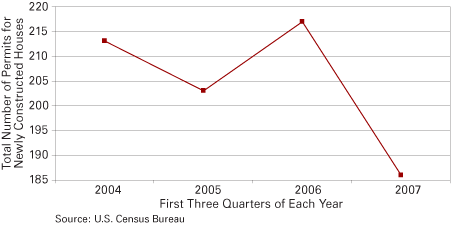Columbus
Teaching Fellow, Division of Business, Indiana University–Purdue University Columbus
The Columbus region has been affected by the overall housing crisis. However, the economic outlook for 2008 is positive but modest. This brief report will provide some important statistics about overall employment, job creation by sector, and the housing market, and will offer predictions on some key variables.
Employment
The unemployment rate for Columbus has decreased 13.8 percent, from 4.4 percent in 2006 to 3.8 percent in 2007. (1) This rate is much lower than the national and state unemployment rates, which equal 4.5 percent and 4.8 percent, respectively. This decrease corresponds to a 2.5 percent increase in the employment level from 36,523 workers to 37,411 workers, a gain of 888 jobs.
Three months after the 2001 recession, which lasted from March 2001 to November 2001 according to the National Bureau of Economic Research, the Columbus area faced its largest recorded unemployment rate of 6 percent. Since that time, there has been a modest recuperation in the labor market. The net gain in jobs was 3,798, putting Columbus' current employment level still 4.5 percent lower than the booming years of the late nineties. This corresponds to a gap of around 1,750 jobs. Hence, there is still some ground to recover. Note, however, that Indiana's current employment is already 2 percent above the 1999 level. An employment comparison between Columbus and the state of Indiana shows a much larger response to the recession in the Columbus area (see Figure 1). This may be due in part to the large dependency Columbus has on the manufacturing sector.
Figure 1
Employment in Columbus and Indiana

Jobs by Sector
The Business Outlook Panel has predicted modest growth in manufacturing jobs for the state in 2008. If this happens, the Columbus area should expect an increase in total jobs for the region. The assumption that an increase in manufacturing jobs can affect total jobs in Columbus comes from the fact that the manufacturing sector accounts for 36 percent of total jobs in Columbus; therefore, the trend in total jobs follows the trend in manufacturing jobs quite closely (see Figure 2).
Figure 2
Quarterly Job Index for Bartholomew County

Even though 36 percent is a significant number, it is 4 percentage points lower compared to the first quarter of 2001, (2) but 2 percentage points higher when compared to the levels in 2003 and 2004. Jobs have grown steadily but modestly in this sector since 2003, from 13,580 in the second quarter of 2003 to 15,565 in the first quarter of 2007. This represents an average quarterly increase in jobs of just 124, which is still 6 percent lower than the number of jobs available during the first quarter of 2001.
The health sector has been gaining importance in Columbus and currently accounts for 12 percent of total jobs. Jobs in this sector have grown 14 percent from 4,470 in the first quarter of 2001 to 5,026 in the first quarter of 2007, which represents the third largest job growth in the region, only losing to retail trade (23 percent) and educational services (35 percent).
The accommodations and food services sector accounts for 7 percent of total jobs and, since the recession, has experienced a 7 percent growth rate, which corresponds to 182 more jobs.
The construction sector represents a small portion of total jobs in Columbus (3 percent). Construction jobs have decreased 15 percent since the first quarter of 2001. For a visual assessment of the relative importance of each sector, see Figure 3.
Figure 3
Bartholomew County Jobs by Sector

Housing
Changes in the number of houses available—measured by the number of permits for newly owned homes—is more volatile in Columbus than in Indiana as a whole. The fact that Columbus housing is more volatile may imply larger swings in the housing market for this region whenever the national economy is in crisis. Therefore, the housing market in Columbus was affected by the national housing crisis.
There was a sharp decline in the number of house permits for the first three quarters of 2007 compared to the first three quarters of 2004, 2005, and 2006 (see Figure 4). Specifically, permits were down 14 percent relative to 2006, from 217 to 186. Therefore, the estimated number for newly constructed houses in 2007 is smaller than in the previous three years.
Figure 4
New Privately Owned Housing Units in Bartholomew County

The Federal Reserve Board reduced interest rates in the latter part of 2007, (3) and the Kelley School of Business forecasts that the rate will be even lower by the end of 2008. These lower rates can affect consumers and businesses positively by reducing the strain on variable rate loans and stimulating new borrowing. This can potentially decrease the number of used houses for sale and increase the number of new permits for newly constructed housing in 2008.
Notes
- Since unemployment data for 2007 were only available until August, for comparison purposes, all yearly unemployment rates were calculated by taking the average monthly unemployment rate from September of the previous year to August of the current year.
- This is the last quarter before the recession officially started.
- The rate dropped 1.25 percentage points from July 2007 to November 2007.
Also in this Issue…
- Outlook for 2008
- The International Economy
- The U.S. Economy
- Financial Forecast
- Housing
- Indiana Agriculture
- Indiana
- Anderson
- Bloomington
- Columbus
- Evansville
- Fort Wayne
- Gary
- Indianapolis-Carmel
- Kokomo
- Louisville
- Muncie
- Richmond
- South Bend-Mishawaka and Elkhart-Goshen
- Terre Haute
- Return to Table of Contents



